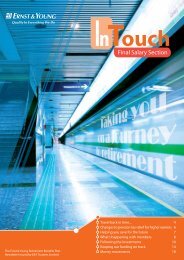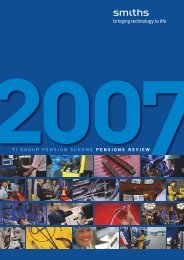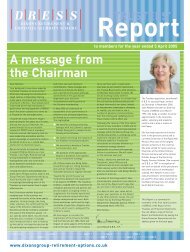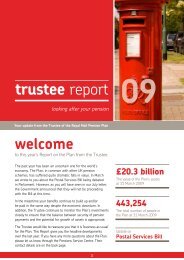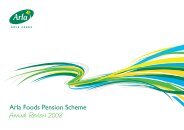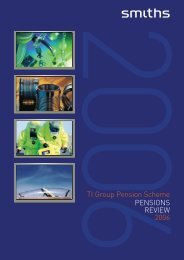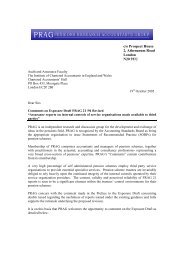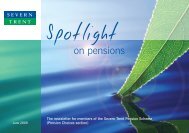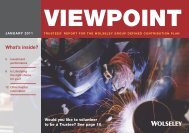Create successful ePaper yourself
Turn your PDF publications into a flip-book with our unique Google optimized e-Paper software.
Trustees’ Report<br />
<strong>Plan</strong>2010<br />
To the members of the<br />
<strong>Hess</strong> <strong>UK</strong> <strong>Pension</strong>
Overview<br />
Contents<br />
2 Overview from the Trustees<br />
6 How the Fund has Changed<br />
over 2009<br />
8 Investment Focus<br />
10 <strong>Pension</strong> Q&A’s<br />
12 Summary of the <strong>Plan</strong><br />
14 Summary Funding Statement<br />
for 2010<br />
16 Taxation of <strong>Pension</strong> Rights<br />
18 Who’s Who<br />
Welcome to the<br />
Trustees’ summary<br />
report for 2010 to<br />
the members of the<br />
<strong>Hess</strong> <strong>UK</strong> <strong>Pension</strong><br />
<strong>Plan</strong>. This is our<br />
opportunity to<br />
remind you of the<br />
benefits that the<br />
<strong>Plan</strong> provides, to<br />
show you how the<br />
<strong>Plan</strong> has developed<br />
since our previous<br />
report and to<br />
update you with<br />
what has been<br />
happening in the<br />
pensions world.<br />
We hope you find<br />
our report useful<br />
and informative.<br />
2 Trustees’ Report 2010
from the Trustees<br />
Let’s start with a brief recap on the key<br />
features of the <strong>Plan</strong>:<br />
• The Company pays all the costs –<br />
you do not have to pay any<br />
contributions;<br />
• The <strong>Plan</strong> provides final-salary benefits<br />
which are not affected by day-to-day<br />
movements in investment markets;<br />
this means that you can predict the<br />
level of benefit you’ll get and plan<br />
your finances well in advance of<br />
retirement;<br />
John Carley<br />
Eric Fishman<br />
• Your family has the financial security<br />
of a pension which is payable on your<br />
death; also, if you die while working<br />
for the Company, a tax free life<br />
assurance sum is paid;<br />
Lydia Latham<br />
David Lutterbach<br />
• If you leave service, you may transfer<br />
the cash value of your pension to an<br />
external scheme; alternatively, the<br />
<strong>Plan</strong> will preserve your pension rights<br />
until you retire;<br />
• There is a cost-effective facility for you<br />
to provide extra benefits by paying<br />
additional voluntary contributions<br />
(“AVCs”).<br />
Nigel McKim<br />
Tony Parmenter<br />
Next, we would like to highlight the<br />
following:<br />
The <strong>Plan</strong>’s Investments<br />
The <strong>Plan</strong>’s £200M investment portfolio<br />
is set up to seek attractive returns over<br />
the long term without running undue<br />
risk. Although “uncertainty” will always<br />
feature in investment markets, the last<br />
two years have been exceptional by<br />
any terms. As a welcome recovery after<br />
the severe downturn in calendar year<br />
2008, the <strong>Plan</strong>’s portfolio achieved a<br />
strong investment return over 2009;<br />
more detail about the investments is<br />
given on pages 6 to 9.<br />
David Peirson-Smith<br />
Benj Sykes<br />
Tax Relief on <strong>Pension</strong>s<br />
The Government is cutting back tax<br />
relief on pension rights. The first step<br />
was an interim measure, covering the<br />
2009/10 and 2010/11 tax years, which<br />
only affected higher earners. However,<br />
in October 2010, some details of the<br />
tax regime to apply from 2011/12<br />
onwards were announced. This new<br />
tax treatment of pension rights will be<br />
important for some members of the<br />
<strong>Plan</strong> and so please do review the<br />
summary on pages 16 and 17.<br />
Trustees’ Report 2010 3
Overview from the<br />
Trustees<br />
continued<br />
The <strong>Plan</strong>’s Funded Status<br />
Following the actuarial valuation at<br />
January 2009, we agreed with the<br />
Company a funding schedule that is<br />
aimed to have the <strong>Plan</strong> fully funded, on<br />
the Scheme Funding basis, by the start<br />
of 2014. Our latest Summary Funding<br />
Statement with the results of the<br />
January 2010 funding review is on<br />
pages 14 and 15 of this report.<br />
Company Covenant<br />
We believe that the <strong>Plan</strong> is supported<br />
by a strong Company covenant, which<br />
in summary means that the Company<br />
can support the level of funding<br />
needed to provide the benefits. The<br />
Company’s commitment to funding<br />
the <strong>Plan</strong> properly is backed up by the<br />
parent company guarantee provided<br />
by <strong>Hess</strong> Corporation. As a standing<br />
agenda item at each Trustees’<br />
Meeting, we review up to date<br />
financial assessments of <strong>Hess</strong><br />
Corporation’s financial performance<br />
and outlook.<br />
Inflation and <strong>Pension</strong> Increases<br />
All pensions in payment are reviewed<br />
annually but, because there was no rise<br />
in inflation over the year to September<br />
2009, no statutory increases were<br />
made to pensions at January 2010.<br />
Further, the Company confirmed that<br />
it would not agree to provide any noncontractual<br />
increases on that date.<br />
Looking forward, the Government has<br />
announced that the Consumer Prices<br />
Index (“CPI”), rather than the RPI, will be<br />
used for statutory increases in company<br />
pension schemes such as the <strong>Plan</strong>.<br />
<strong>Plan</strong> Governance<br />
We have kept all the <strong>Plan</strong>’s operations<br />
under close review through detailed<br />
quarterly reports from our accountant,<br />
actuary, administrator, and investment<br />
consultant. In addition, our Investment<br />
Sub-Committee has been meeting<br />
monthly to review investment<br />
performance, assess proposed<br />
changes to the portfolio and deal<br />
with routine operational matters.<br />
Trustee Board<br />
Benj Sykes resigned as a Trustee at the<br />
end of 2010. Benj had been the longest<br />
serving Trustee and we thank him for<br />
his substantial contribution to the work<br />
of the Trustees over the years. The<br />
Company has appointed Barbara Wilton<br />
to become a Trustee with effect from<br />
1 December 2010.<br />
Audited Accounts<br />
You should note that this report<br />
contains only an extract from the<br />
audited statutory accounts for 2009<br />
in which the auditor’s opinions on<br />
the financial statements and on the<br />
summary of contributions were<br />
unqualified. Our formal report<br />
containing the <strong>Plan</strong>’s full audited<br />
accounts and other technical<br />
details is available on request to:<br />
Trustees of the <strong>Hess</strong> <strong>UK</strong> <strong>Pension</strong> <strong>Plan</strong>,<br />
c/o <strong>Hess</strong> Services <strong>UK</strong> Limited,<br />
The Adelphi Building,<br />
1-11 John Adam Street,<br />
London WC2N 6AG<br />
or by email to:<br />
<strong>Pension</strong><strong>Plan</strong>@hess.com<br />
4 Trustees’ Report 2010
We would like to hear what you think about the <strong>Plan</strong> so please feel free to<br />
give your comments and suggestions to any of the Trustees or by email to:<br />
<strong>Pension</strong><strong>Plan</strong>@hess.com<br />
John Carley<br />
Eric Fishman<br />
Lydia Latham<br />
D G Lutterbach<br />
Nigel McKim<br />
Tony Parmenter<br />
David Peirson-Smith<br />
Benj Sykes<br />
Trustees’ Report 2010 5
How the Fund has<br />
changed over 2009<br />
Fund value including AVCs<br />
£133,631,000 1 January 2009<br />
Into the Fund was paid<br />
Employer contributions 25,197,000<br />
Members’ AVCs 755,000<br />
Transfers from other plans 161,000<br />
Investment income 404,000<br />
Total 26,517,000<br />
Out of the Fund was paid<br />
Benefits to members 2,898,000<br />
Transfers to other plans 497,000<br />
Life assurance premium 485,000<br />
Total 3,880,000<br />
The market value of the investments increased by<br />
£27,694,000<br />
Fund value<br />
£183,962,000 31 December 2009<br />
Membership of the <strong>Plan</strong><br />
End of year<br />
133<br />
Start of year<br />
121<br />
380<br />
389<br />
1,116<br />
1,099<br />
Current employees Deferred members <strong>Pension</strong>ers and dependants<br />
6 Trustees’ Report 2010
Trustees’ Report 2010 7
Investment<br />
Fund Growth since 1985<br />
£m<br />
190<br />
180<br />
170<br />
160<br />
150<br />
140<br />
130<br />
120<br />
110<br />
100<br />
90<br />
80<br />
70<br />
60<br />
50<br />
40<br />
30<br />
20<br />
10<br />
0<br />
1985<br />
1986<br />
1987<br />
1988<br />
1989<br />
1990<br />
1991<br />
1992<br />
1993<br />
1994<br />
1995<br />
1996<br />
1997<br />
1998<br />
1999<br />
In September 2008, the collapse<br />
of Lehman Brothers triggered<br />
governments around the world to<br />
intervene dramatically in markets<br />
to restore confidence in the global<br />
financial system and, at this stage,<br />
the full outcome of the banking crisis<br />
and the effectiveness of the remedial<br />
measures being taken are still<br />
unclear. However, investment markets<br />
have started to stabilise and the<br />
<strong>Plan</strong>’s investment gains in 2009 went<br />
some way towards compensating for<br />
the massive downturn experienced<br />
in 2008. These two years show how<br />
investment markets can fluctuate<br />
dramatically in the short term; overall,<br />
the <strong>Plan</strong>’s investments returned<br />
18.5% in 2009 compared with a return<br />
of minus 23.4% in 2008. And yet, the<br />
investment return on the portfolio<br />
over the first 3 quarters of 2010 has<br />
only been modest and the outlook<br />
remains volatile.<br />
This volatility of investment markets is<br />
perhaps best illustrated by the section<br />
of the portfolio where, via an Emerging<br />
Markets equity fund, the <strong>Plan</strong> invests<br />
in shares of companies operating in<br />
countries such as Brazil, China, India,<br />
Korea and Russia. Relative to investing<br />
in the <strong>UK</strong> equity market, this sector is<br />
projected to provide a higher rate of<br />
Total number of<br />
current active<br />
members<br />
return over the long term but with<br />
returns that are likely to vary more<br />
widely. The chart below shows the<br />
US$ returns achieved each month of<br />
the Emerging Markets equity fund<br />
since the start of 2008.<br />
US$ Returns of Emerging markets<br />
equity fund (31 Jan 2008 to 30 Sep 2010)<br />
% Return (US$)<br />
20<br />
15<br />
10<br />
5<br />
0<br />
-5<br />
-10<br />
-15<br />
-20<br />
-25<br />
-30<br />
31 Jan 08<br />
31 Mar 08<br />
30 Jun 08<br />
30 Sep 08<br />
31 Dec 08<br />
31 Jan 09<br />
31 Mar 09<br />
30 Jun 09<br />
30 Sep 09<br />
31 Dec 09<br />
Number of employees<br />
Fund value<br />
(including AVCs)<br />
2000<br />
2001<br />
2002<br />
2003<br />
2004<br />
2005<br />
2006<br />
2007<br />
2008<br />
2009<br />
900<br />
800<br />
700<br />
600<br />
500<br />
400<br />
300<br />
200<br />
100<br />
31 Jan 10<br />
31 Mar 10<br />
30 Jun 10<br />
30 Sep 10<br />
Looking backwards in time, it would of<br />
course have been fantastic for the <strong>Plan</strong><br />
to have been invested in this sector<br />
for purely the quarters which showed<br />
positive returns. However, no investor has<br />
the benefit of hindsight and instead we<br />
have to construct a portfolio that aims<br />
to strike a reasonable balance between<br />
achieving gains in rising markets and<br />
avoiding losses in adverse times.<br />
0<br />
8 Trustees’ Report 2010
Focus<br />
Target Asset Allocation<br />
% Returns (+/-)<br />
Actual<br />
Returns<br />
Benchmark<br />
Returns<br />
Calendar 2009 18.5% 15.8%<br />
ENTIRE PORTFOLIO<br />
Q1:Q3 2010 5.8% 4.8%<br />
0 5 10 15 20<br />
Global Equities 37%<br />
Hedge Funds 24%<br />
Bonds 12%<br />
Venture Capital<br />
& Private Equity 10%<br />
Real Assets 10%<br />
Emerging Market<br />
Equities 5%<br />
Cash 2%<br />
The importance of “not<br />
putting all the eggs in one<br />
basket” lead us to develop,<br />
with the advice of the <strong>Plan</strong>’s<br />
investment consultants, our<br />
diversified asset strategy for<br />
the portfolio which is shown<br />
in the chart above. You will<br />
see that the proportion of<br />
the <strong>Plan</strong>’s assets that is<br />
invested in Emerging Market<br />
equities represents only 5%<br />
of the entire portfolio.<br />
We track the performance of<br />
the investment managers<br />
within each of the sectors<br />
by comparing the returns<br />
actually achieved with<br />
benchmarks based on how<br />
the underlying markets have<br />
performed. Where any of<br />
our managers underperform<br />
for a sustained period,<br />
we and our investment<br />
consultants research the<br />
reasons why this has<br />
occurred and judge whether<br />
this should be treated as<br />
purely a temporary reversal<br />
or whether – perhaps<br />
because of changes in<br />
personnel – the manager<br />
should be replaced.<br />
0 10 20 30 40<br />
0 30 60 90 120 150<br />
0 5 10 15 20 25 30 35<br />
0 10 20 30 40 50<br />
-5 0 5 10 15 20<br />
% Returns (+/-)<br />
Calendar 2009 18.3% 20.7%<br />
Global Market equities<br />
Q1:Q3 2010 5.5% 3.3%<br />
Calendar 2009 69.0% 59.4%<br />
Emerging Market equities<br />
Q1:Q3 2010 19.3% 13.8%<br />
Calendar 2009 19.7% 13.1%<br />
Hedge Funds<br />
Q1:Q3 2010 3.7% 4.6%<br />
Calendar 2009 25.6% 22.5%<br />
Real Assets<br />
Q1:Q3 2010 9.3% 9.4%<br />
Calendar 2009 -2.2% -2.0%<br />
Bonds<br />
Q1:Q3 2010 9.5% 9.5%<br />
The charts above show the actual investment<br />
returns and benchmark returns on the main asset<br />
classes within the portfolio; you should note that<br />
these returns allow for the currency hedging process<br />
that we have put in place. No figures are shown for<br />
the Venture Capital/Private Equity component as our<br />
investments into these funds are being established<br />
on a gradually phased basis and short term<br />
indicators/returns for these asset classes are<br />
meaningless.<br />
In summary, we are keeping all of our managers<br />
under close review and continue to believe that the<br />
current diversified portfolio remains appropriate for<br />
the <strong>Plan</strong>. We will keep you updated in future reports.<br />
Trustees’ Report 2010 9
<strong>Pension</strong> Q&A’s<br />
Some of us may remember the old days when the subject of “pensions” was rarely<br />
mentioned in the media but life is very different now. Here are some pointers<br />
through the pensions maze:<br />
How are the Company’s contributions to the <strong>Plan</strong> worked out?<br />
The Trustees commission regular actuarial valuations of the <strong>Plan</strong>’s assets and<br />
liabilities. Based on these valuations, the Trustees will agree with the Company how<br />
much should be contributed. The amount of the Company’s contributions may go<br />
up or go down following such actuarial valuations.<br />
How does increasing life expectancy affect the <strong>Plan</strong>?<br />
All the evidence indicates that people born more recently tend to live longer. According<br />
to a recent study, once men born in 1980 reach age 60, they are expected to live on<br />
average for another 33 years whereas men reaching age 60 this year (i.e. born in 1950)<br />
are expected to survive for an average of 29 years. Please note that these are merely<br />
averages, some people will live for longer and others for less. Allowing for increased life<br />
expectancy makes pension plans more expensive simply because the pensions are<br />
likely to be paid for a longer period. Very roughly, each extra year of life expectancy that<br />
we assume for the <strong>Plan</strong>’s membership will add a further £5 million to the amount<br />
needed to support the pension rights that have already been earned.<br />
How can the <strong>Plan</strong> afford to pay out the “death in service” benefits?<br />
The cash value of the life assurance lump sums and dependant’s pensions that<br />
would be paid if every in-service member of the <strong>Plan</strong> died is around £280 million!<br />
At first sight, there might appear to be a problem because this is considerably more<br />
than the £200 million currently held by the <strong>Plan</strong>. However, there are no grounds for<br />
concern because the <strong>Plan</strong> does not rely on its own resources to pay the death in<br />
service benefits; instead, these benefits are insured and so the sums paid out by<br />
the <strong>Plan</strong> are reclaimed from the insurer.<br />
This explains why the <strong>Plan</strong> restricts a member’s death in service benefits to the level<br />
for which insurance cover has been secured; only very few members have any such<br />
restriction and each is individually informed.<br />
10 Trustees’ Report 2010
While on the subject of life assurance … please remember to update your<br />
Beneficiary Nomination Form if your personal circumstances change. In the event<br />
of a member’s death, the Trustees would use this form to help decide who should<br />
be paid the benefits. You can get a new form for this purpose from your local<br />
Human Resources department.<br />
What would happen if the <strong>Plan</strong> were wound-up?<br />
The Company would have to pay into the <strong>Plan</strong> enough money to enable all<br />
members’ accrued benefits to be completely secured with an insurance<br />
company. If the Company did not have enough money to do this then the Parent<br />
Company Guarantee provided by <strong>Hess</strong> Corporation would be activated. Only if<br />
<strong>Hess</strong> Corporation was unable to pay in the extra funding would members receive<br />
less than their accrued benefits. At the extreme, the <strong>Pension</strong> Protection Fund<br />
(“PPF”) might be able to take over the <strong>Plan</strong> and pay compensation to members.<br />
For more information, visit the PPF’s website at<br />
www.pensionprotectionfund.org.uk.<br />
What happens if I leave <strong>Hess</strong>?<br />
Provided you’ve completed at least two years’ membership, the pension that you<br />
have earned up to when you leave will remain in the <strong>Plan</strong> until you choose to<br />
have it paid – at any age between 60 and 65. After leaving, the pension will be<br />
increased each year to help maintain its real value. Alternatively, you can choose<br />
to have the cash value of your pension paid over to another approved pension<br />
arrangement – this could be a personal pension or the pension scheme of your<br />
new employer.<br />
Everyone who leaves <strong>Hess</strong> is promptly sent full details of their preserved pension<br />
rights; all the Trustees ask of you is to keep the <strong>Plan</strong>’s administrators informed of<br />
any change to your address.<br />
Why does the <strong>Plan</strong> invest in Hedge Funds?<br />
Around a quarter of the <strong>Plan</strong>’s portfolio is invested in hedge funds and so they<br />
have an important role in the Trustees’ overall investment strategy. The first point<br />
to emphasise is that there is a very wide variety of Hedge Funds and that the<br />
specific funds used by the <strong>Hess</strong> <strong>Plan</strong> are all at the cautious end of the range;<br />
further, very detailed due diligence is carried out by the Trustees’ investment<br />
consultants and lawyer before any new Hedge Fund manager is selected. The<br />
main aim of investing in Hedge Funds is to increase the diversification of the<br />
<strong>Plan</strong>’s portfolio because these funds can still provide a relatively good return<br />
when equity markets generally are falling.<br />
Can my <strong>Hess</strong> pension be shared on divorce?<br />
Yes. Couples can divide between themselves the pension rights that they have<br />
earned up to the time of the divorce. <strong>Pension</strong>s are divided by means of a formal<br />
“pension sharing order” or, more usually in Scotland, by a negotiated agreement<br />
between the parties. When a pension entitlement in the <strong>Hess</strong> <strong>Plan</strong> is shared, part<br />
of the value of the member’s pension is transferred to an external pension<br />
arrangement for the benefit of the ex-spouse. A briefing note with full details<br />
about how the <strong>Plan</strong> operates pension sharing is available on request from the<br />
<strong>Plan</strong>’s administrator.<br />
Trustees’ Report 2010 11
Summary of<br />
The <strong>Hess</strong> <strong>UK</strong> <strong>Pension</strong> <strong>Plan</strong> is non-contributory<br />
in that the Company, <strong>Hess</strong> Services <strong>UK</strong><br />
Limited, bears the whole cost. The Company’s<br />
level of contribution is likely to vary from time<br />
to time following actuarial assessments of the<br />
<strong>Plan</strong>’s financial status.<br />
Your Normal Retirement Date (“NRD”) is<br />
65 but members also have the flexibility<br />
to retire at any age between 60 and 65.<br />
When you retire, your retirement benefits<br />
will come from three sources:<br />
1. <strong>Hess</strong> <strong>UK</strong> <strong>Pension</strong> <strong>Plan</strong><br />
Your pension will be paid monthly in<br />
advance and is based on 1.85% of<br />
your Final <strong>Pension</strong>able Salary multiplied<br />
by the number of completed years and<br />
months of pensionable service. When<br />
you retire, you may elect to exchange<br />
part of your pension for a cash sum<br />
(currently tax-free). Your pension for<br />
service after April 1997 will be<br />
increased each year at the rate of price<br />
inflation capped at 5.0% for 1997/2005<br />
benefits and at 2.5% for post April<br />
2005 benefits; further discretionary<br />
increases may also be paid. Provisions<br />
are also in place to compensate<br />
spouses/partners and children<br />
following the death of a pensioner.<br />
2. Basic State <strong>Pension</strong> Scheme<br />
As at April 2010, the Basic State<br />
<strong>Pension</strong> was £5,078 per annum for a<br />
single person and £8,120 per annum<br />
for a married couple.<br />
3. State Second <strong>Pension</strong><br />
(“S2P”, previously known as SERPS)<br />
You should note that the <strong>Plan</strong> as a<br />
whole contracted out of S2P on<br />
1 January 2001. As a result, with effect<br />
from then, members pay a reduced rate<br />
of National Insurance contribution and<br />
will earn no further benefits under S2P.<br />
However, you will retain the right to any<br />
S2P pension that you earned prior to<br />
being contracted out.<br />
The <strong>Hess</strong> <strong>UK</strong> <strong>Pension</strong> <strong>Plan</strong> also<br />
provides the following benefits:<br />
Early retirement<br />
With the Company’s consent, you may<br />
retire between the age of 55 and 60<br />
provided you have completed ten years’<br />
service. In this event, a reduction to your<br />
pension will be made to allow for early<br />
payment.<br />
Death in service<br />
If you die whilst a member of the <strong>Plan</strong>,<br />
a tax-free lump sum of 2.5 times your<br />
pensionable salary will be paid. In<br />
addition your spouse or nominated<br />
dependant will receive a pension of<br />
50% of your prospective pension. If you<br />
have children under the age of 18 (or<br />
21 if in full-time education), a proportion<br />
of your prospective pension will be paid<br />
until they attain that age: 20% for one<br />
child and 10% each for the next three<br />
children. These figures will be doubled<br />
if no spouse’s or dependant’s pension<br />
is payable.<br />
Transfers-in<br />
You are permitted to transfer any<br />
pension rights from previous pension<br />
arrangements into the <strong>Plan</strong>. An actuarial<br />
assessment will advise you of the<br />
options available.<br />
Leaving service<br />
If you leave the <strong>Plan</strong> before your NRD<br />
having completed more than two years’<br />
service you may either transfer your<br />
pension value to an alternative pension<br />
scheme, or receive a deferred pension.<br />
The deferred pension will be revalued<br />
each year between the date of leaving<br />
service and your NRD at the rate of<br />
price inflation capped at 5.0% for<br />
benefits earned before April 2009<br />
and at 2.5% for benefits earned after<br />
April 2009.<br />
12 Trustees’ Report 2010
the <strong>Plan</strong><br />
Benefit limits<br />
All payments from the <strong>Plan</strong> are subject<br />
to HMRC regulations; benefits paid on<br />
death in service are restricted to the<br />
level for which insurance cover has<br />
been secured.<br />
Please refer to the <strong>Pension</strong> <strong>Plan</strong> Guide<br />
for further details. This can be obtained<br />
from HR in London.<br />
Trustees’ Report 2010 13
Summary Funding State<br />
One of our most important tasks as Trustees<br />
is to monitor whether the <strong>Plan</strong> remains<br />
financially strong enough to pay all the<br />
members’ benefits – not just the pensions<br />
that are currently in payment but all the<br />
pensions that will become payable in the<br />
future as members come to retire.<br />
In line with legislation, we monitor the<br />
<strong>Plan</strong>’s financial position through regular<br />
actuarial valuations of the <strong>Plan</strong>’s assets<br />
and liabilities. Full valuations are carried<br />
out every three years and we also<br />
receive annual updating reports from<br />
our actuary. Each year, we provide<br />
members with a summary of the <strong>Plan</strong>’s<br />
funding position and this year’s is set<br />
out below.<br />
On-going Basis<br />
When assessing the <strong>Plan</strong>’s finances on<br />
an on-going basis, we assume that the<br />
<strong>Plan</strong> will continue into the future with<br />
the Company remaining willing and<br />
able to provide full financial support.<br />
Taking account of the <strong>Pension</strong><br />
Regulator’s Code of Practice and<br />
advice from our actuary, we are<br />
responsible for setting the assumptions<br />
used to value the <strong>Plan</strong>’s liabilities<br />
and these are documented in our<br />
Statement of Funding Principles.<br />
liabilities) of 67%. We agreed with the<br />
Company a Recovery <strong>Plan</strong> to address<br />
this shortfall which involves the<br />
Company paying in £72.6 million over<br />
the period to January 2014. These<br />
recovery payments will be reviewed in<br />
the light of further actuarial valuations.<br />
The actuary’s updating report at<br />
1 January 2010 showed that the shortfall<br />
had reduced from £65.2 million to<br />
£21.3 million, before including the<br />
recovery payment of £14.7 million paid<br />
by the Company later in January 2010.<br />
The improvement to the <strong>Plan</strong>’s funding<br />
position was principally due to the<br />
significant amount contributed by the<br />
Company and good investment<br />
performance of the <strong>Plan</strong>’s portfolio.<br />
The most recent full actuarial valuation<br />
of the <strong>Plan</strong> at 1 January 2009 showed<br />
that the assets were £133.6 million<br />
and that the amount needed to provide<br />
members’ accrued benefits was<br />
£198.8 million. Accordingly, the <strong>Plan</strong><br />
had a shortfall of £65.2 million and a<br />
funded status (ratio of assets to<br />
Solvency Buy-Out Basis<br />
Another approach to assessing the<br />
<strong>Plan</strong>’s financial position is to test<br />
whether the <strong>Plan</strong> has enough money<br />
for an insurance company to take over<br />
responsibility for all the benefits that<br />
members have earned to date. The<br />
latest estimate by the actuary is that<br />
14 Trustees’ Report 2010
ment for 2010<br />
becoming available under the Parent<br />
Company Guarantee. We have no<br />
reason to regard the winding up of<br />
the <strong>Plan</strong> as a likely event and this<br />
information is provided solely for<br />
regulatory purposes.<br />
Importance of the Company’s<br />
support<br />
Our objective is to have enough assets<br />
in the <strong>Plan</strong> to enable all benefits to be<br />
paid to members. To meet this objective,<br />
the <strong>Plan</strong> relies on the Company’s<br />
continued support because (i) the<br />
Company is paying for benefits earned<br />
by employed members each year and<br />
(ii) the funding level can fluctuate from<br />
time to time and, when there is a<br />
funding shortfall, the Company is likely<br />
to have to increase its contribution. The<br />
commitment of the Company to funding<br />
the <strong>Plan</strong> properly is backed up by the<br />
Parent Company Guarantee provided<br />
by <strong>Hess</strong> Corporation.<br />
And to note …<br />
There is a statutory requirement for us<br />
to confirm to the membership whether<br />
any sums have been paid by the <strong>Plan</strong><br />
to the Company; we are pleased to<br />
confirm that no such payments have<br />
been made.<br />
the <strong>Plan</strong> had<br />
a funded status on this<br />
basis of 41% at 1 January 2009.<br />
This level of cover may seem low but it<br />
is not unusual amongst <strong>UK</strong> pension<br />
plans; this is because buying-out<br />
benefits is more expensive than<br />
providing pensions directly from the<br />
<strong>Plan</strong>. Importantly, this figure is only<br />
relevant if the <strong>Plan</strong> were wound up with<br />
the Company being unable to meet the<br />
shortfall and with no extra funding<br />
If you would like more information<br />
about the actuarial valuation then<br />
please contact our pension advisors:<br />
Bluefin at 9 Greyfriars Road, Reading,<br />
Berkshire RG1 1NU or by email to:<br />
Robert.Hart@Bluefingroup.co.uk<br />
Trustees’ Report 2010 15
Taxation of<br />
<strong>Pension</strong> Rights<br />
The basic principles of how the<br />
Government taxes the benefits<br />
provided by company pension<br />
schemes such as the <strong>Plan</strong> have<br />
remained the same for many years<br />
and are relatively straightforward:<br />
• <strong>Pension</strong>s in payment are taxed as<br />
earned income.<br />
• Provided the amounts are not<br />
“excessive”, lump sums on death<br />
or retirement are paid tax-free.<br />
Private Medical scheme counts<br />
as a “benefit in kind” on which<br />
you have to pay tax but you are<br />
not taxed on any actual payouts<br />
made from that scheme to the<br />
healthcare provider.<br />
The rules about what counts as<br />
“excessive” pension benefits are<br />
based on two separate “Allowances”:<br />
• There is an Annual Allowance (“AA”) for<br />
the maximum amount of “new pension<br />
rights” which is allowable tax-free in any<br />
one year. For members of the <strong>Plan</strong>, “new<br />
pension rights” are the total of:<br />
• The cash value of the extra pension<br />
earned in the <strong>Hess</strong> <strong>Plan</strong>, and;<br />
• Any contributions you pay by way of<br />
AVCs or to an individual pension policy.<br />
• Again, provided the<br />
amounts are not “excessive”,<br />
pension rights can be built up over<br />
your working life without any tax charge<br />
– this includes giving full tax relief to<br />
AVCs paid by members.<br />
In overview, the benefits are taxed once<br />
they come into payment but, subject<br />
to upper limits, there is no tax paid on<br />
the value of pension rights as they are<br />
built up. There is a clear contrast here<br />
between pensions and, say, the Private<br />
Medical scheme provided by the<br />
Company; each year’s cost of the<br />
If the value of your new pension rights in<br />
any tax-year is over the AA then you have<br />
to pay a tax on the excess.<br />
• There is a Life Time Allowance (“LTA”)<br />
for the maximum pension value that<br />
can benefit from tax relief. This is tested<br />
when you come to retire and if the value<br />
of your benefits is greater than the LTA<br />
then you’ll have a tax charge to pay.<br />
Initially, these allowances were set at<br />
such generous levels that few members<br />
were affected. However, the Government<br />
has decided that too much tax relief is<br />
being given to pensions and announced<br />
in October 2010 that these allowances<br />
16 Trustees’ Report 2010
would be reduced from 2011/12, very substantially so for the Annual Allowance. As a<br />
caution though, you should note that there are a number of important areas where,<br />
as of the date of this report, we are waiting for further details to be published.<br />
Build-Up of <strong>Pension</strong> Rights<br />
The starting point is that from 2011/12 everyone will have full tax relief on new<br />
pension rights up to an Annual Allowance of £50,000 in each tax year, significantly<br />
less than the £255,000 that applies for 2010/11.<br />
For members of the <strong>Plan</strong>, the value of their new pension rights in 2011/12 is worked<br />
out as in the following example:<br />
A) How much pension have you<br />
earned at 6 April 2011?<br />
B) How much pension have you<br />
earned at 5 April 2012?<br />
Years of service<br />
<strong>Pension</strong>able salary<br />
10 years<br />
£60,000 pa<br />
Years of service<br />
<strong>Pension</strong>able salary<br />
11 years<br />
£65,000 pa<br />
Start Year <strong>Pension</strong><br />
is 10 x £60,000 x 1.85% = £11,100 pa<br />
End Year <strong>Pension</strong><br />
is 11 x £65,000 x 1.85% = £13,228 pa<br />
Suppose inflation over 2011/12 is 3% then adjust your Start Year <strong>Pension</strong> for inflation<br />
£11,100 x 1.03 = £11,433 pa<br />
Take your<br />
End Year <strong>Pension</strong> £13,228 pa<br />
Take off your Adjusted<br />
Start Year <strong>Pension</strong> £11,433 pa<br />
Giving a<br />
Growth in <strong>Pension</strong><br />
of £1,795 pa<br />
C) New <strong>Pension</strong> Rights<br />
multiply your growth in pension<br />
by 16 to get £28,720<br />
To get the value of your new pension rights, multiply your growth in pension by<br />
16 to get £28,720. Since this is below the £50,000 allowance, you will have no tax<br />
charge; also you would have scope to pay AVCs of up to £21,280 (taking the total<br />
up to £50,000) and get full tax relief on these contributions.<br />
If you do these sums with your own personal details and get above £50,000 as the<br />
value of your new pension rights, you might still not have any tax to pay because<br />
any unused allowance from the 3 previous years can be carried forward.<br />
To help you out with the calculations, we will continue to provide all in-service<br />
members with Annual Allowance statements – as we have already been doing<br />
to date.<br />
Maximum Value at Retirement<br />
To get the value of your retirement benefits, multiply your pension by 20 and add on<br />
any cash sum you’ll be taking. If this value is below the Life Time Allowance then<br />
you will have no tax charge. The amount of this allowance is £1.8 million for 2010/11<br />
and 2011/12 but will reduce to £1.5 million for 2012/13. However, the Government<br />
has announced that protective measures will be available to individuals who have<br />
already accrued substantial pension rights.<br />
Further information about these new tax rules will be issued once the final details<br />
have been confirmed.<br />
Trustees’ Report 2010 17
Who’s Who<br />
The Trustees<br />
The Trustees of the <strong>Plan</strong> during 2009<br />
were:<br />
Date of Appointment<br />
J A Carley (MNT) 1 February 2007<br />
E S Fishman 1 September 2008<br />
L P Latham 1 April 2008<br />
D G Lutterbach 1 March 2006<br />
N B McKim (MNT) 1 January 2009<br />
A E Newman (MNT) 1 February 2007<br />
(resigned 1 December 2009)<br />
A Parmenter (MNT) 1 January 2009<br />
D M Peirson-Smith 1 November 2009<br />
B J Sykes 20 November 2003<br />
R E Thompson 20 November 2003<br />
(resigned 1 November 2009)<br />
The Member Nominated Trustees<br />
(“MNTs”) at the end of 2009 were J A<br />
Carley, N B McKim and A Parmenter.<br />
Apart from reimbursement of expenses,<br />
the Trustees do not receive any<br />
remuneration for their work on the <strong>Plan</strong>.<br />
Professional advisers<br />
The Trustees retain professional<br />
advisers to help them run the <strong>Plan</strong>.<br />
They are as follows:<br />
Administrator and actuary<br />
Bluefin<br />
9 Greyfriars Road, Reading,<br />
Berkshire RG1 1NU<br />
Handle the administration of the<br />
<strong>Plan</strong>, e.g. transfers-in/out, benefit<br />
calculations. Carry out annual actuarial<br />
valuations to check the <strong>Plan</strong> has<br />
sufficient assets to meet the costs of<br />
the benefits and to advise on the level<br />
of contributions which HS<strong>UK</strong>L needs to<br />
pay. Provide specialist advice on all<br />
pension matters.<br />
Solicitor<br />
Farrer & Co.<br />
66 Lincoln’s Inn Fields,<br />
London WC2A 3LH<br />
Provide specialist advice and<br />
assist with the legal requirements/<br />
documentation of the <strong>Plan</strong>,<br />
e.g. Trust Deed and Rules.<br />
AVC provider<br />
Skandia Life Assurance Company<br />
Limited<br />
Skandia House, Portland Terrace,<br />
Southampton SO14 7EJ<br />
Operate the in-house AVC facility and<br />
invest the AVCs paid by members in a<br />
range of managed funds.<br />
Accountant<br />
Kelvin Archer Limited<br />
Cob Suite, Old Swan House,<br />
29 High Street, Hemel Hempstead,<br />
Herts HP1 3AA<br />
Prepare annual accounts of the <strong>Plan</strong>.<br />
Auditor<br />
Ernst & Young LLP<br />
Apex Plaza, Reading, Berkshire<br />
RG1 1YE<br />
Carry out the annual audit of the <strong>Plan</strong><br />
and ensure the accounts comply with<br />
statutory requirements.<br />
Investment consultant<br />
Cambridge Associates Limited<br />
Cardinal Place, 80 Victoria Street,<br />
London SW1E 5JL<br />
Advise the Trustees on investment<br />
strategy and investment manager<br />
selection/monitoring; provide regular<br />
analyses of investment performance.<br />
Further information<br />
Please contact:<br />
Trustees of the <strong>Hess</strong> <strong>UK</strong> <strong>Pension</strong> <strong>Plan</strong>,<br />
c/o <strong>Hess</strong> Services <strong>UK</strong> Limited,<br />
The Adelphi Building,<br />
1-11 John Adam Street,<br />
London WC2N 6AG<br />
or by email to:<br />
<strong>Pension</strong><strong>Plan</strong>@hess.com<br />
18 Trustees’ Report 2010
<strong>Hess</strong> Services <strong>UK</strong> Limited<br />
Level 9<br />
The Adelphi Building<br />
1-11 John Adam Street<br />
London WC2N 6AG<br />
Tel: 020 7331 3000<br />
Recycled<br />
Supporting responsible use<br />
of forest resources<br />
www.fsc.org Cert no. SA COC 001654 CQ<br />
© 1996 Forest Stewardship Council<br />
Designed and produced by Paperwork Corporate Design Ltd<br />
Telephone +44 (0)20 7407 7111 Email p@perwork.com



